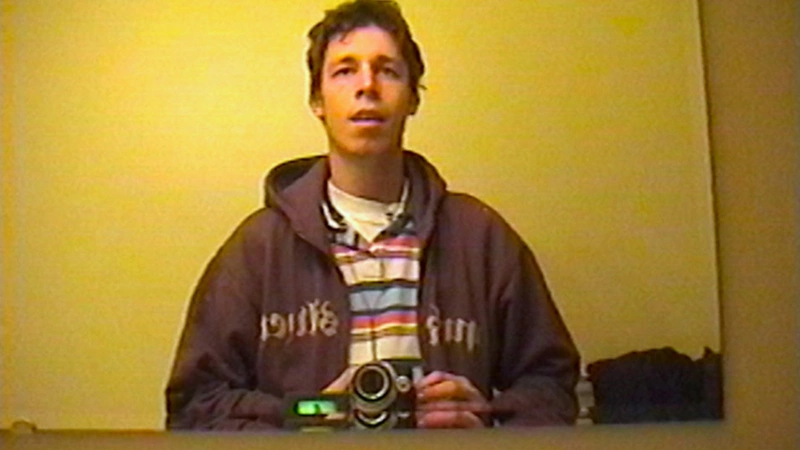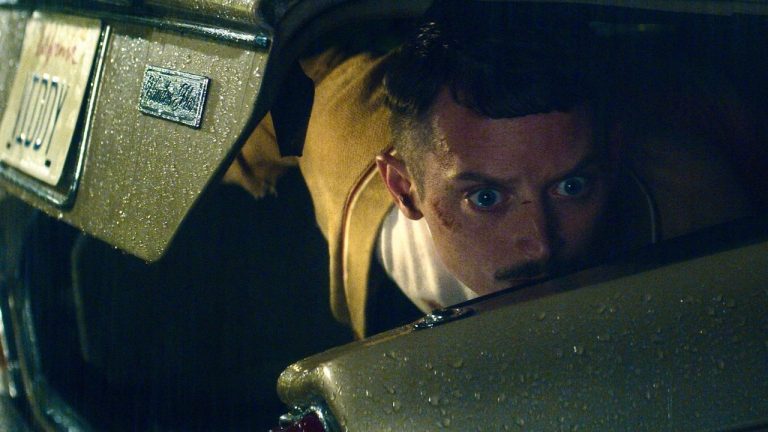Behold the life of a man in torment. Billy Poulin has been filming his thoughts for 20 years, and without knowing it, he recorded the chronicles of a schizophrenic in the most detailed way possible. His material is the backbone of the documentary, technically directed by Lawrence Cote-Collins, a Canadian filmmaker with a keen and empathetic eye on contemporary emotional destruction. Billy apparently has a natural way of telling stories and an original passion for deploying props (wigs, puppets, and costumes). Although he stopped his endeavors for a career in filmmaking early on, he found solace in placing his creativity in front of the camera.
Over the years, he developed an archive of him either playing with thoughts or rambling on record. Surely, this archive has been a record of Billy’s descent into schizophrenia; while many are self-tapes of monologues and diaristic commentary, quite a few are performances of scripted, fictional instances. When Billy was lucid, he had been reflecting, perhaps unconsciously, on his troubled thoughts via conjured short scenarios. What we gather is a case of a lonely man with a brilliant mind capable of reaching a higher level of thinking that, combined with a lack of interpersonal exchange and love (and some strong, exponential addictions), prompted his distance from social norms and elicited his mental illness.
Although the above description falls short of the complexities of schizophrenia, it does give some perspective on the responsibility of society over the outburst of such disorders. As complex it is to tell how such an expressive man never managed any friendship or relationship, as easy it gets (by the orchestration and edits of Lawrence) to grasp that his resourcefulness and dialectics trapped him in obscure misconceptions of reality. It leads him into atypical behavior and later on into a holistic withdrawal from any normative thinking. This story is not set to reaffirm the thin line between genius and madness, but it does illustrate bit by bit how a mind can slip down hard.
This slip for Billy led him one step further down—to murder and, so, imprisonment. The recording of his interrogation, which keeps coming back to the story delivered by Lawrence, takes (to our surprise) different shapes as Billy’s past unfolds in a somewhat convoluted timeline. This choice is a punchy reminder that the reasoning behind violence and crime, in the case of Billy and any, is nonlinear and perplexing.

While being lonely for most of his life, this new form of alienation imposed by incarceration urged him to reach out for company. Lawrence Cote-Collins, his peer from his early career, steps in as a filmmaker and picks up the call. Lawrence, in turn, found her meaning in this call and in the immense archive of Billy’s VHS recordings. The visual aspect of the documentary mainly relies on Billy’s archive. At the same time, this footage gained a sense of a different dimension under Lawrence’s skillful hands. The story crafted by Lawrence is a narrative of their commonalities and differences, juxtaposed with Billy’s footage.
From a cinematic perspective, this is a very resonating method to deploy the inner reality of an individual, regularly inaccessible to others. In this case, besides the aberrant and violent character of Billy, Lawrence is voicing her own demons: alcohol addiction and suicidal ideation. As the film goes on, their relationship evolves into a rare bond, leading to the most heartfelt ending. Yes, Billy confronts himself with his mental disorder and criminal actions and consecutively declares his shame and despair. However, what makes this finale tear-jerking is what follows his confession; when he concludes his statement of remorse, the disarmed look he gives back to Lawrence is the look of someone relieved to be exposed to someone who cares.
The director dedicated a significant amount of time to voicing the letters Billy had been writing to her from the time he spent in prison, making this documentary an extraordinary testimony of a mental disorder. In these poignant writings, we get immersed not only in the inner sufferings of schizophrenia but also in the abnormal (and dehumanizing in plain sight) conditions set by imprisonment. His enlightening descriptions of mental and physical isolation often dissolve the distinction between the two. Billy used an overwhelmingly rich language to describe his turmoil, so vibrant and vibrating that any poet would kneel before. It is mainly through these letters that we get exposed to the constitution of an ill-fated mind that we can formulate any possible sincere understanding without necessarily asking for sympathy.
Lawrence proves, with Billy’s expressiveness, that love can help us understand our trouble, identify it concretely, name it when it’s happening, and ultimately provide an opportunity out of it. This might sound banal or tacky, but along with medical support and appropriate medication, interpersonal relationships are essential for an individual to have a chance to single out one’s place, find meaning in the world, and, hopefully, heal.

![Manchester By The Sea [2016]: Devastating tale of a broken man.](https://79468c92.delivery.rocketcdn.me/wp-content/uploads/2017/02/Manchester-by-the-sea-768x512.jpg)
![The Devil’s Backbone [2001]: Del Toro’s Gothic Allegory](https://79468c92.delivery.rocketcdn.me/wp-content/uploads/2017/05/910THHbGcOL._SL1500_-768x508.jpg)
![Asking for It [2022] Review: An Extreme and Chaotic Representation of Female Vigilantism](https://79468c92.delivery.rocketcdn.me/wp-content/uploads/2022/02/Asking-for-It-2021-768x432.png)


